![Nelson Stevens, Centennial Vision, Tuskegee University Administration Building, AL, 1980 [destroyed].jpg.gif Nelson Stevens, Centennial Vision, Tuskegee University Administration Building, AL, 1980 [destroyed].jpg.gif](https://486312.frmmmguz.asia/files/square_thumbnails/1a0ef8af8ec25559e5c2c7c66502ba40.jpg)
Centennial Vision
In 1980, on the anniversary of the founding of the Tuskegee Institute, AfriCOBRA member Nelson Stevens created a mural to celebrate the occasion. Although Stevens was commonly an exterior mural painter, he created this mural on the inside of the Tuskegee University Administration Building. The mural contains the images of black history figures such as Booker T. Washington (former president of Tuskegee University), General Chappie James and the Tuskegee airmen of World War II, Cinque, Malcolm X, Martin Luther King Jr., and George Washington Carver, as well as the antislavery figures Harriet Tubman, Sojourner Truth and Frederick Douglass. Also included in the image is a phrase made famous by the African scholar John S. Mbiti, “I Am Because We Are.” This mural no longer exists.
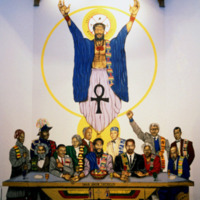
Last Supper
In 1990, muralist Maurice Myron Jenkins created an alternative version of Leonardo da Vinci’s 1494 fresco The Last Supper. The 30 by 19 foot mural depicts the last supper with a black Christ and 12 historical black figures as the prophets. Jenkins chose the Union Temple Baptist Church in Anacostia, Washington D.C. as his canvas because of its role in black history all the way back to its affiliation with Anacostia-resident Frederick Douglass in the 19th century.The mural includes the antislavery figures of Sojourner Truth and Frederick Douglass, as well as Marcus Garvey, Martin Luther King Jr., Rosa Parks, Elijah Muhammad, Malcolm X, Mary McLeod Bethune, Nelson Mandela, Booker T. Washington and W.E.B. Du Bois.
![Mary Patten, Douglass Street Mural, 389 Douglass St, Brooklyn, NY, 1976 [destroyed 1989].jpg Mary Patten, Douglass Street Mural, 389 Douglass St, Brooklyn, NY, 1976 [destroyed 1989].jpg](https://486312.frmmmguz.asia/files/square_thumbnails/95232a9ffb9e9bde28fc73b69fc9109a.jpg)
Douglass Street Mural
Mary Patten painted Douglass Street Mural – Cityarts Workshop’s first Brooklyn-based project – in 1976. Over a five-month period, Patten led a group of 20 teens and adults to develop various themes for the mural that would be located on Douglass Street in the Park Slope area of Brooklyn - an area more commercial than residential at the time. Community meetings and bilingual flyers filled the neighbourhood in the hope of garnering community input and consensus over the choice of imagery. The three-storey mural takes advantage of the building's structure by presenting the image as book pages waiting to be read. The dystopian nightmare to the right-hand side of the mural attempts to encroach on the multicultural utopian melting pot to the left, only to be fended off by workers and important figures from U.S. history. Folded into the Puerto Rican flag and the red, white and green banner of the African National Congress, are the images of Harriet Tubman, pointing towards the nightmare-scape, alongside Frederick Douglass, Lolita Lebrón, Malcolm X and H. Rap Brown. Under the imperialist eagle and puppet-like figure in its talons, Patten depicts a recent firebombing that had destroyed the homes of several Black families a few blocks away. Speaking of the large rainbow in the image, the muralist incorporated it to show "what is possible when people work and fight together to create what we need: a community school that provides quality education; people sharing skills and tools; dancing together; making music and painting a mural."The mural sought to convey hope and determination in the face of oppression. But by the 1980s, the mural had become obscured by new housing developments.
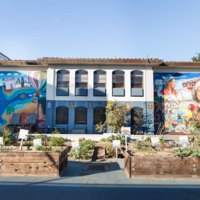
Now and Then
In 1996, the Rafael Elementary School in San Francisco changed its name to Rosa Parks Elementary School, and the San Francisco School Board president commissioned a mural to mark the new name. The mural was a community effort by students from the Art Institute, the Academy of Art and San Francisco State University. It aimed to make children aware of Rosa Parks. Once the mural was finished, Parks herself came to unveil it. Also included on the wall are the antislavery figures Harriet Tubman and Frederick Douglass, as well as Thurgood Marshal and W.E.B. Du Bois.
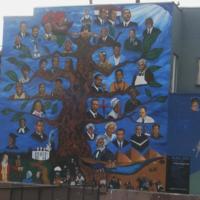
Black Seeds
In 1991, a group of artists – Eddie Orr, David Mosley, William T. Stubbs, Norman Maxwell and Michael McKenzie – collaborated to paint “Black Seeds” on an empty wall in Leslie N. Shaw Park on Jefferson and 3rd Avenue in Los Angeles. The idea for the mural, which appears as an African American tree of life, came from Vietnam veteran and local activist Gus Harris Jr. He recalled how little he learned about African American history in school. He wanted to create a public mural about black individuals who made an important contribution to society.The mural was created under the Social and Public Art Resource Center's 1990-91 “Neigborhood Pride: Great Walls Unlimited” mural program and features the antislavery leaders Harriet Tubman and Frederick Douglass, as well as Booker T. Washington, Thurgood Marshall, Mary McLeod Bethune, Malcolm X, George Washington Carver, Paul Robeson, Stevie Wonder, Shirley Chisholm, Martin Luther King Jr., and Jesse Jackson. The mural was restored by Moses X. Ball to include Barack Obama after 2008. The original canvas upon which the mural was based hangs in Oaks Jr. Market Corner Store at 5th and Jefferson.
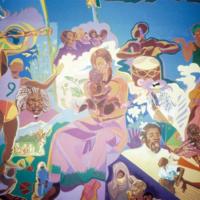
Races of the Student Population
In 1976, the Mexican muralist Manuel Martinez created a mural at Auraria College titled Races of the Student Population. It depicts the antislavery leader Frederick Douglass alongside figures of the Black Power Movement including Bobby Seale, and figures and symbols of the African diaspora.
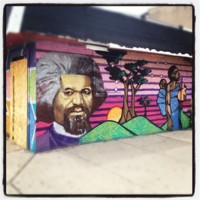
North Lawndale Mural
A teacher at North Lawndale College Preparatory Charter High School, Katie Bordner, created this mural with her students in 2012. It depicts the abolitionist Frederick Douglass, a mother and child and an African backdrop.
![Don Rodgers, Our Brothers and Sisters, 100th and Halsted Streets [Black Neighborhood], Chicago, 1984.jpg Don Rodgers, Our Brothers and Sisters, 100th and Halsted Streets [Black Neighborhood], Chicago, 1984.jpg](https://486312.frmmmguz.asia/files/square_thumbnails/ade8cb4554aca77fae33825bf55434dc.jpg)
Our Brothers and Sisters
Titled Our Brothers and Sisters, this mural depicts figures of black history, including the abolitionist Frederick Douglass and also Harold Washington, Martin Luther King Jr., Booker T. Washington, Malcolm X, W.E.B. Du Bois, and Louis Armstrong.
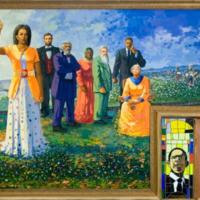
From Menelik I to Obama
Ethiopian artist Mekbib Gebertsadik put the abolitionist Frederick Douglass alongside President Lincoln, the abolitionist John Brown, Malcolm X, President Obama and Michelle Obama. Titling the mural From Menelik I to Obama, Gebertsadik also placeed Douglass on a timeline of diasporic history that starts with Menelik I, the first Solomonic Emperor of Ethiopia in 950 BC, to President Barack Obama, the first African American president. The mural is a few blocks away from the White House at the Gospel Rescue Ministries homeless shelter, acting as a symbol of hope for those passing through. “Primarily, the clients we serve are African American and [the mural is] an inspiration to our clients of being able to dream” explains Earl Murray, Associate Director for Development and Marketing for Gospel Rescue Ministries.